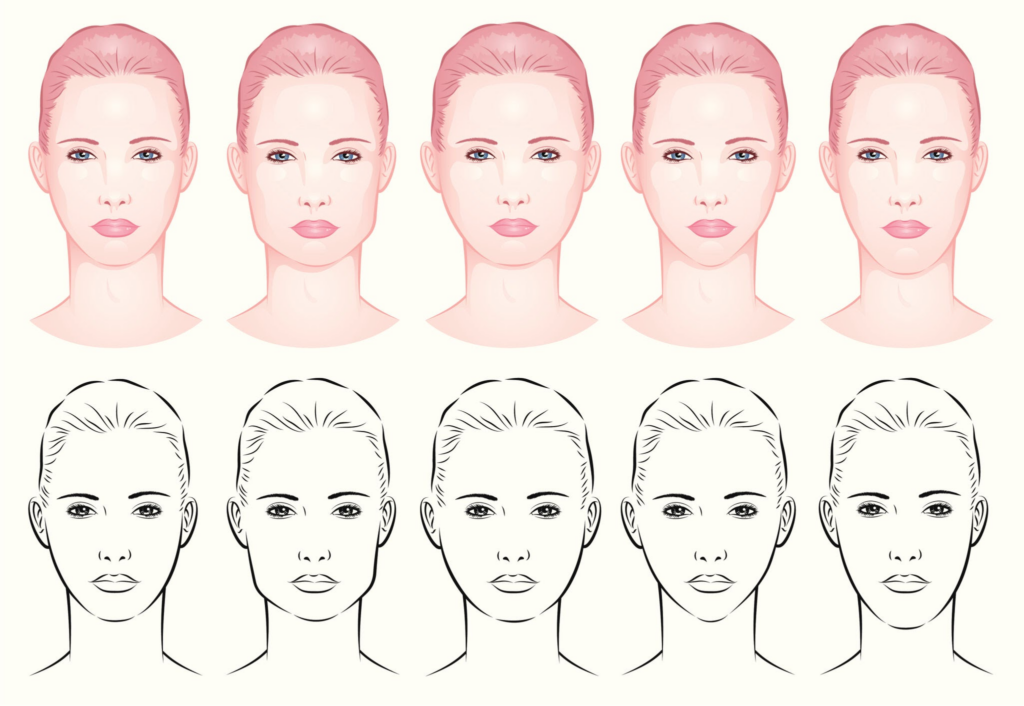What are the different techniques used for jawline reduction in FFS? For many transgender women and individuals seeking a more feminine appearance, a prominent jawline can feel like a roadblock on their journey. Facial Feminization Surgery (FFS) offers a powerful tool to reshape and refine this area, creating a more delicate and balanced profile. But with an array of surgical approaches available, navigating the world of FFS jawline reduction can feel overwhelming. Fear not, lovely readers! This guide will delve into the secrets behind achieving a softer jawline through FFS, empowering you to make informed decisions about this transformative procedure.

Table of Contents
Surgical Sculpting: Reshaping the Jaw for Femininity
Let’s face it (pun intended!), the jaw plays a crucial role in defining facial contours. In general, male jawlines tend to be wider, squarer, and more angular, while feminine jawlines are typically smoother, rounded, and less prominent. FFS surgeons utilize various techniques to achieve this delicate balance.
One of the most common approaches is mandibular angle reduction. This procedure involves carefully reshaping the bony angles at the back of the jaw, creating a softer, more curved jawline. Imagine transforming a sharp V-shape into a gentler U-shape.
Another option is mandibular setback. This technique involves repositioning the entire jawbone slightly backward, creating a more recessed appearance and reducing overall jaw projection. Think of it as subtly pushing the jawline back a step, creating a more balanced profile.

A Multifaceted Approach: Beyond Bone Reduction
While bone reduction plays a significant role, FFS jawline refinement extends beyond just the underlying structure. Surgeons often employ additional techniques to achieve optimal results.
- Liposuction: Stubborn pockets of fat can contribute to a bulky jawline. Liposuction techniques can be used to remove excess fat deposits, creating a more sculpted and defined appearance.
- Chin reduction: A prominent chin can throw off the balance of a feminine jawline. Chin reduction surgery involves reshaping or shaving down the bony chin projection, creating a more delicate and balanced profile.
- Soft tissue augmentation: Fillers or fat grafting can be used to enhance the jawline and create a smoother contour. By strategically adding volume to specific areas, surgeons can soften sharp angles and define the jawline for a more feminine look.
Imagine an artist wielding a paintbrush and chisel. FFS surgeons combine these techniques like a maestro, sculpting the jawline with both bone reduction and soft tissue manipulation to create a truly harmonious and feminine result.
The Art of Individuality: Tailoring Jawline Reduction
One of the hallmarks of a skilled FFS surgeon is their ability to individualize treatment plans. No two faces are exactly alike, and what works for one person might not be the best approach for another. A thorough consultation will involve discussing your aesthetic goals, facial anatomy, and desired outcome.
Factors like skin elasticity, bone density, and underlying facial structure will all influence the surgeon’s choice of technique. For example, someone with a thicker jaw might benefit more from a combination of mandibular angle reduction and setback, while someone with a naturally slender jaw might only require strategic soft tissue augmentation.
Here’s a fun analogy: Think of your jawline as a piece of clay. A skilled FFS surgeon is the sculptor, carefully molding and shaping it to bring out your unique beauty and achieve the delicate features you desire.
This concludes part one of our exploration into FFS jawline reduction. In the upcoming sections, we’ll delve deeper into advanced technologies, choosing the right technique, and the art of individualized treatment plans. Stay tuned, lovely readers, for more insights into achieving the jawline of your dreams!
Embracing Innovation: Advanced Technologies for Jawline Reduction
The world of FFS is constantly evolving, embracing innovative technologies to enhance surgical precision and minimize recovery times. Here are some cutting-edge techniques shaking things up in the realm of jawline reduction:
- Piezoelectric Surgery: This technology utilizes ultrasonic vibrations to reshape bone with exceptional accuracy. Imagine a tiny, high-tech chisel gently sculpting your jawline, minimizing damage to surrounding tissues and potentially leading to faster healing times.
- Computer-Aided Design/Computer-Aided Manufacturing (CAD/CAM): This dynamic duo allows surgeons to create customized surgical plans using 3D imaging technology. Think of it as a virtual blueprint for your jawline transformation. By mapping out the exact amount of bone reduction needed, surgeons can achieve a more predictable and precise outcome.
- Virtual Surgical Planning (VSP): VSP takes things a step further by allowing you to virtually see your potential results before surgery. Imagine gazing into a digital mirror and witnessing the softer, more feminine jawline of your dreams. This technology can be a powerful tool for communication and setting realistic expectations.
While these advancements are exciting, it’s important to remember that experienced surgical skill remains paramount. The best technology in the world is only as good as the surgeon wielding it.

Choosing Your Weapon: Selecting the Right Jawline Reduction Technique
With an arsenal of techniques at their disposal, how do you and your surgeon decide on the best approach for your FFS jawline reduction? Here are some key factors to consider:
- Your desired outcome: Be clear about what you hope to achieve. Do you want a subtle softening of your jawline, or a more dramatic transformation? Discussing your aesthetic goals with your surgeon is crucial for choosing the right technique.
- Facial anatomy: Every face is unique, and your surgeon will assess your bone structure, skin elasticity, and underlying tissues to determine the most suitable approach. Imagine your facial anatomy as a puzzle – the chosen technique needs to fit seamlessly with your individual features.
- Surgical experience: Choose a board-certified facial plastic surgeon with extensive experience in FFS procedures, particularly jawline reduction. Look for a surgeon who showcases a strong portfolio of before-and-after photos demonstrating their expertise in achieving natural-looking feminine jawlines.
Remember, the best technique isn’t a one-size-fits-all solution. A skilled surgeon will consider your unique needs and goals to craft a personalized treatment plan that optimizes your results.
The Art of Individualization: Tailoring Jawline Reduction
In part one, we discussed the importance of individualized care in FFS jawline reduction. Now, let’s delve deeper into this crucial aspect.
During your consultation, your surgeon will likely:
- Evaluate your facial features: They’ll meticulously assess your jawline angles, bone density, skin quality, and overall facial structure. This comprehensive examination helps them understand your starting point and determine the most effective techniques.
- Discuss your aesthetic goals: Be open and honest about what you envision for your jawline. Do you dream of a subtly rounded look, or a more dramatic transformation? The clearer your communication, the better your surgeon can tailor the treatment plan to your desires.
- Develop a customized approach: Based on your facial anatomy and aesthetic goals, the surgeon will recommend a combination of techniques to achieve the optimal outcome. This personalized approach ensures you receive the treatment that best suits your unique needs.
Imagine your jawline as a blank canvas. A skilled FFS surgeon acts as the artist, using their experience and expertise to create a masterpiece – a beautiful, feminine jawline that reflects your inner essence.
Here’s a table summarizing the different jawline reduction techniques and their potential benefits:
| Technique | Benefits |
|---|---|
| Mandibular Angle Reduction | Reduces prominence of jaw angles, creates a softer jawline |
| Mandibular Setback | Recesses the entire jawbone, creates a more balanced profile |
| Liposuction | Removes excess fat deposits, defines the jawline |
| Chin Reduction | Reshapes or shaves down the bony chin projection, creates a more delicate look |
| Soft Tissue Augmentation | Enhances jawline definition and softens sharp angles |
Remember, this table provides a general overview. The best approach for you will depend on your individual needs and facial anatomy.

The Road to Transformation: Considerations for FFS Jawline Reduction
So, you’ve decided to embark on the journey of FFS jawline reduction. Here are some essential considerations to navigate this exciting, yet transformative, experience:
- Choosing the right surgeon: This is arguably the most crucial decision. Seek a board-certified facial plastic surgeon with extensive experience in FFS, particularly jawline contouring. Look for surgeons who actively participate in FFS conferences and workshops, demonstrating their commitment to staying at the forefront of this specialized field. Don’t hesitate to schedule consultations with multiple surgeons to find one you feel comfortable and confident with – someone who listens attentively to your goals and addresses your concerns comprehensively.
- Realistic expectations: FFS jawline reduction is a powerful tool, but it’s not magic. Discuss realistic outcomes with your surgeon based on your individual anatomy. Remember, the goal is to achieve a natural-looking feminine jawline that complements your overall facial features, not to completely erase your masculine characteristics.
- The importance of communication: Open and honest communication with your surgeon is vital throughout the entire process. Don’t be shy about asking questions, expressing your concerns, and discussing your desired outcome in detail. The more your surgeon understands your vision, the better they can tailor the treatment plan to achieve your goals.
- Preparing for surgery: Once you’ve chosen your surgeon and finalized the treatment plan, it’s time to prepare for surgery itself. Your surgeon will provide detailed instructions regarding pre-operative medications, dietary restrictions, and any necessary tests. Following these instructions meticulously helps ensure a smooth surgery and optimal recovery.
- Recovery and aftercare: FFS jawline reduction is typically an outpatient procedure, but recovery times can vary depending on the techniques used and the extent of the surgery. Expect some swelling, bruising, and discomfort in the first few days following surgery. Your surgeon will provide you with detailed aftercare instructions, including pain management strategies, dietary recommendations, and wound care protocols. Following these instructions diligently is crucial for optimal healing and achieving the best possible results.
Remember, FFS jawline reduction is a personal journey. By choosing a skilled and experienced surgeon, setting realistic expectations, and diligently following pre- and post-operative instructions, you can embark on a transformative path towards achieving the delicate jawline of your dreams.
Visit Dr.MFO Instagram profile to see real patient transformations! Get a glimpse of the incredible results achieved through facial feminization surgery and other procedures. The profile showcases before-and-after photos that highlight Dr. MFO’s expertise and artistic vision in creating natural-looking, beautiful outcomes.
Ready to take the next step in your journey? Schedule a free consultation with Dr. MFO today. During the consultation, you can discuss your goals, ask any questions you may have, and learn more about how Dr. MFO can help you achieve your desired look. Don’t hesitate to take advantage of this free opportunity to explore your options and see if Dr. MFO is the right fit for you.
FAQs
1. Will FFS jawline reduction permanently change my jawline?
Yes, FFS jawline reduction techniques like mandibular angle reduction and setback involve bone reshaping, leading to permanent changes in your jawline structure. However, some techniques like liposuction may require touch-up procedures in the future due to natural fat deposits.
2. Are there any risks associated with FFS jawline reduction?
As with any surgery, FFS jawline reduction carries some inherent risks. These may include infection, bleeding, nerve damage, and temporary or permanent numbness in the jaw area. Choosing a board-certified facial plastic surgeon with extensive experience in FFS minimizes these risks. A thorough consultation allows you to discuss these risks in detail with your surgeon and make an informed decision.
3. How long does it take to see the final results of FFS jawline reduction?
Significant swelling and bruising can occur after surgery, so it may take several weeks to see the initial definition of your new jawline. However, the full results can take up to a year to fully emerge as swelling subsides and soft tissues settle.





